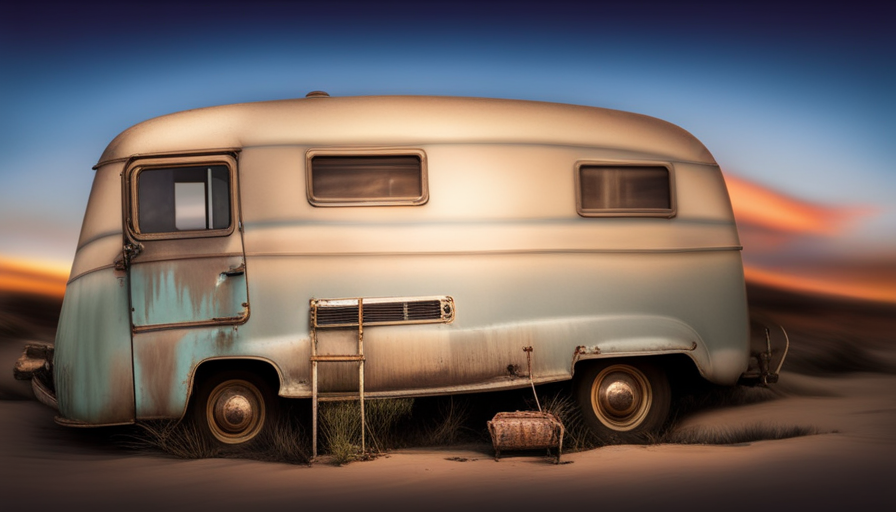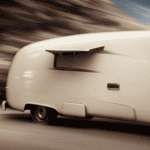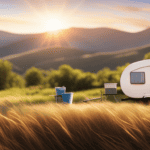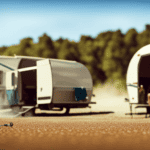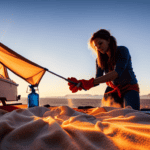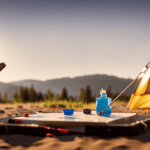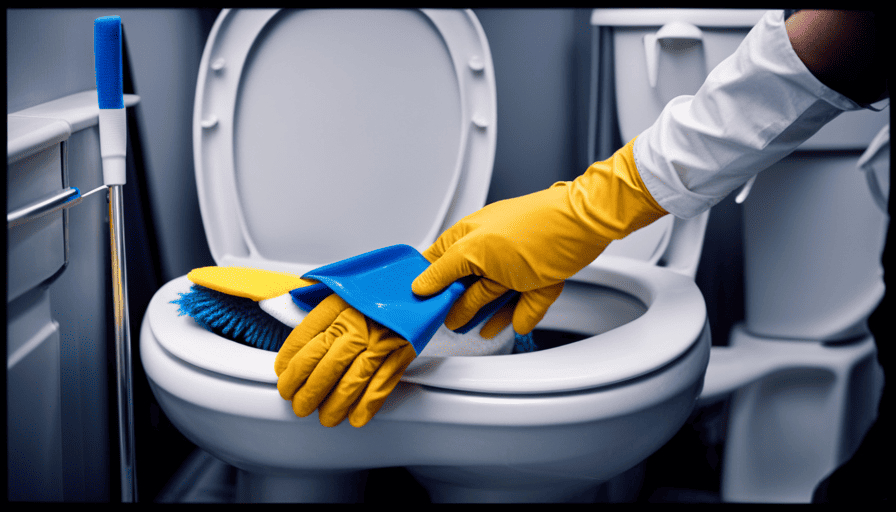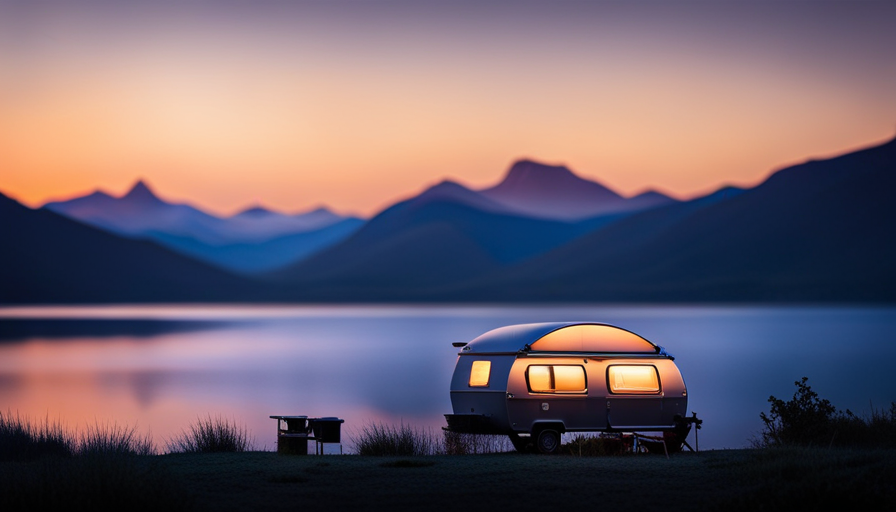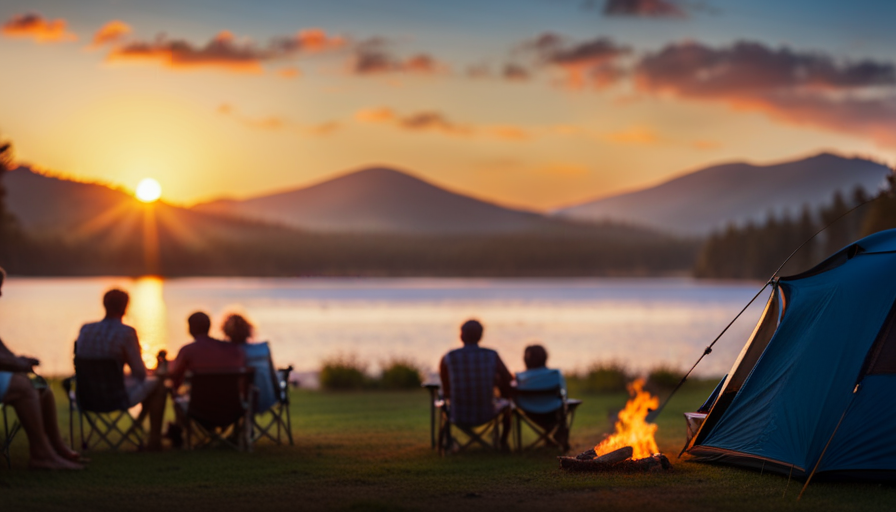Remember the excitement and feeling of accomplishment you felt when you brought your camper home for the first time? Its pristine white exterior was ready to take on any adventures that came its way.
But over time, exposure to the elements and the wear and tear of travel can leave your camper looking dull and worn. That’s where I come in. In this article, I’ll share with you my tried and true method for bringing your camper back to its original pristine white glory.
With a thorough assessment, the right cleaning supplies, and a little elbow grease, we’ll remove stubborn stains, polish, wax, and pay attention to every detail. I’ll even share tips on how to protect your camper from future damage and keep it looking white for years to come.
So, let’s get started on restoring your camper to its former radiant self and get ready to hit the road in style!
Key Takeaways
- Assess the condition of the camper before starting the restoration process
- Gather necessary cleaning supplies for the exterior wash and polishing
- Clean the interior surfaces and upholstery with appropriate cleaners
- Regularly maintain and protect the camper’s exterior to prevent future stains and damage
Assess the Condition of Your Camper
Take a closer look at your camper’s condition and discover how to bring back its pristine white color!
Evaluating the damage is the first step in determining the best course of action. Inspect the camper’s exterior for any signs of discoloration, stains, or fading. Pay special attention to areas that are frequently exposed to the elements, such as the roof and sides. This will help you identify the extent of the damage and plan accordingly.
Once you’ve assessed the condition of your camper, it’s time to choose the right cleaning products. Different types of stains require different treatments, so it’s important to use the appropriate products to achieve the best results. For general dirt and grime, a mild detergent mixed with warm water should suffice. For tougher stains like bird droppings or tree sap, you may need to use a specialized cleaner or solvent.
Gather the necessary cleaning supplies, including brushes, sponges, and microfiber cloths. These tools will help you effectively clean and restore your camper’s white color. With the right products and tools in hand, you can now move on to the next step of the process: removing the stains and bringing back the camper’s original shine.
Gather the Necessary Cleaning Supplies
To restore its pristine appearance, gather the essential cleaning supplies that’ll bring a radiant glow back to your beloved home on wheels. When it comes to cleaning your camper, having the right tools and products is crucial.
Start by assembling a bucket, a soft-bristle brush, a microfiber cloth, a sponge, a pressure washer (if available), and a selection of cleaning agents specifically formulated for different surfaces.
For the exterior, begin with a thorough wash using a mild detergent and warm water. Scrub gently with the soft-bristle brush to remove any dirt or grime. If your camper has stubborn stains or oxidation, consider using a specialized cleaner or wax to restore its original shine. Pay attention to the windows, wheels, and any other visible areas that may need extra attention.
Moving onto the interior, begin by removing any loose items and vacuuming the floors and upholstery. For hard surfaces such as countertops and cabinets, use a multipurpose cleaner that’s safe for the material. For fabrics and upholstery, spot clean with a fabric cleaner or mild detergent. Don’t forget to clean the windows and mirrors using a glass cleaner for a streak-free finish.
With these cleaning techniques and the best cleaning products, your camper will soon be sparkling clean and ready for your next adventure. Start with a thorough exterior wash, ensuring every nook and cranny is free of dirt and grime.
Start with a Thorough Exterior Wash
Begin by giving your beloved home on wheels a refreshing makeover with a thorough exterior wash that’ll bring back its radiant glow. Maintaining the cleanliness of your camper’s exterior is essential to keep it looking pristine and to protect it from dirt and grime.
To start, gather the necessary cleaning supplies such as a bucket, sponge or brush, mild soap specifically formulated for RVs, and a hose with an adjustable nozzle. When choosing cleaning products, opt for ones that are safe for your camper’s exterior material and won’t cause any damage.
Before you begin, make sure to park your camper in a shaded area to prevent the soap from drying too quickly.
Start by rinsing the entire camper with water to remove loose dirt and debris. Then, mix the mild soap with water in the bucket and use a sponge or brush to gently scrub the exterior, paying attention to any stubborn areas.
Rinse thoroughly with water to remove all soap residue.
To remove stubborn stains and mildew, continue to the next section where we’ll discuss effective methods and products.
Remove Stubborn Stains and Mildew
If your camper has encountered some tough stains and pesky mildew, don’t worry – there’s a solution to bring back its pristine shine. Removing tough stains and preventing discoloration is essential to get your camper looking like new again.
Start by identifying the type of stain you’re dealing with, whether it’s bird droppings, tree sap, or rust. Each stain requires a different approach for effective removal. For bird droppings, a mixture of warm water and mild dish soap can do the trick. Gently scrub the affected area with a soft brush or sponge, being careful not to scratch the surface.
For tree sap, rubbing alcohol or nail polish remover can be effective. Apply a small amount to a cloth and gently rub the stain until it lifts. Rust stains can be more challenging, but using a rust remover specifically designed for vehicles can help.
Once the stains are removed, it’s important to rinse the area thoroughly to prevent any residue from causing discoloration.
Transitioning into the next section, after removing the stubborn stains and mildew, it’s time to give your camper a well-deserved polish and wax for a smooth finish.
Polish and Wax for a Smooth Finish
Achieve a sleek, glossy look by giving your camper a thorough polish and wax for a flawless finish.
When it comes to polishing your camper, there are a few techniques you can use to ensure the best results. Start by washing the exterior surface to remove any dirt or debris. Then, apply a high-quality automotive polish using a soft cloth or a polishing machine. Work in small sections, applying firm pressure and using circular motions to buff away any imperfections. This will help restore the shine and remove any light scratches or oxidation.
Once you have completed the polishing process, it’s important to protect the exterior surface by applying a layer of wax. Waxing not only adds a layer of protection against the elements, but it also enhances the shine and gives your camper a smooth finish. Choose a wax that’s specifically formulated for RVs and apply it using a clean cloth or applicator pad. Allow the wax to dry to a haze, then buff it off using a microfiber cloth. This will leave your camper looking shiny and new.
By polishing and waxing your camper, you not only enhance its appearance but also protect it from the elements. The polishing process removes imperfections and restores the shine, while the waxing process adds a layer of protection and enhances the gloss.
Once you have achieved a smooth and glossy finish on the exterior, it’s time to move on to the next step – cleaning and restoring the interior surfaces.
Clean and Restore the Interior Surfaces
Transform the inside of your camper into a pristine oasis by diving into the task of cleaning and reviving its interior surfaces. Here are four cleaning techniques and products that’ll help you achieve remarkable results:
-
Start by vacuuming and dusting: Remove any loose dirt and debris from the surfaces using a high-quality vacuum cleaner. Don’t forget to clean the vents and hard-to-reach areas. Follow up with a microfiber cloth to dust off any remaining particles.
-
Deep clean the upholstery: Use a fabric cleaner specifically designed for camper interiors. Apply the cleaner to a soft brush and gently scrub the upholstery in circular motions. Rinse with a clean, damp cloth and let it air dry.
-
Revive the dashboard and trim: To bring back the shine, use a non-greasy dashboard cleaner. Apply a small amount on a microfiber cloth and wipe the surfaces thoroughly. For stubborn stains, use a soft-bristle brush and a mild all-purpose cleaner.
-
Refresh the carpets and mats: Use a carpet cleaner designed for automotive use. Apply the cleaner to the carpets and mats, following the manufacturer’s instructions. Use a brush or sponge to agitate the cleaner and remove any stains. Finish by vacuuming the area to remove any excess moisture.
Now that the interior surfaces are clean and revived, let’s move on to the next step: paying attention to detail, including the windows, wheels, and trim.
Pay Attention to Detail: Windows, Wheels, and Trim
Now it’s time to give special care to the windows, wheels, and trim of your camper. Choosing the right cleaning products for your camper is crucial in maintaining its pristine appearance.
When it comes to the windows, opt for a high-quality glass cleaner that’s safe for use on tinted windows. Avoid using ammonia-based cleaners as they can damage the window tint.
For the wheels, use a good wheel cleaner specifically designed for RVs. This will help remove dirt, brake dust, and grime effectively.
Additionally, pay attention to the trim of your camper. This area is prone to fading and discoloration due to exposure to sunlight and harsh weather conditions. Look for a trim restorer that’s suitable for your specific trim material, whether it’s plastic, rubber, or vinyl.
Regularly clean and maintain the cleanliness of your camper’s windows and trim. This is essential to keep them looking their best. Remember to clean them thoroughly, paying attention to any hard-to-reach areas. By doing so, you’ll not only enhance the overall appearance of your camper but also protect it from future stains and damage.
Protect Your Camper from Future Stains and Damage
To safeguard your camper against future stains and damage, it’s crucial to employ preventive measures and maintain a regular cleaning routine.
By taking the necessary steps, you can prolong the lifespan of your camper and prevent future discoloration. One important preventive measure is to apply a protective wax or sealant to the exterior of your camper. This will create a barrier that shields against dirt, grime, and UV rays, which can cause fading and discoloration over time.
Additionally, consider investing in covers for your camper’s windows, wheels, and trim. These covers will provide an extra layer of protection against the elements and potential stains.
In terms of cleaning, make sure to regularly wash your camper using a mild detergent and a soft cloth or sponge. Avoid using harsh chemicals or abrasive materials that could cause damage to the camper’s surface. Pay special attention to any areas that are prone to staining, such as the roof and awning.
It’s also important to inspect and clean the camper’s water system regularly to prevent any potential leaks or water damage.
By following these preventive measures and maintaining a regular cleaning routine, you can keep your camper looking white and in top condition for years to come.
Regular Maintenance to Keep Your Camper Looking White
Ensure your camper remains in pristine condition by regularly performing maintenance tasks to keep it looking as good as new. By following these regular maintenance tips, you can prevent discoloration and keep your camper white for years to come.
| Maintenance Task | Frequency |
|---|---|
| Wash the exterior | Every 2 weeks |
| Wax the exterior | Every 3 months |
| Clean the roof and awnings | Every 6 months |
| Inspect and repair any damages | Every 6 months |
| Protect against UV rays and dirt | Yearly |
Regularly washing the exterior of your camper is crucial to prevent dirt and grime buildup, which can lead to discoloration. Use a mild soap and a soft brush or sponge to gently scrub the surface. After washing, apply a coat of wax to protect the paint and maintain its shine. Don’t forget to clean the roof and awnings as well to prevent any potential discoloration.
Inspect your camper every six months for any damages, such as cracks or leaks, and repair them promptly. Additionally, consider applying a protective sealant to guard against UV rays and dirt accumulation, especially on vulnerable areas.
By following these regular maintenance tips, you can keep your camper looking white and beautiful. Now, enjoy your newly restored white camper and get ready for your next adventure!
Enjoy Your Newly Restored White Camper!
Get ready to hit the road in your gleaming, snow-white camper, soaking up the sun and creating unforgettable memories along the way! After putting in the hard work to restore your camper to its original white glory, it’s time to reap the benefits of a clean and well-maintained vehicle.
One of the main benefits of having a clean camper is the improved aesthetics. A white camper gives off a fresh and crisp appearance, making it stand out among the rest. It’s a reflection of your attention to detail and pride in ownership. Not only will you feel proud driving around in a sparkling white camper, but it’ll also turn heads and make a positive impression on others.
In addition to the visual appeal, a clean camper is also easier to maintain. Regular maintenance, such as washing and waxing, will become a breeze when your camper is white. Dirt, grime, and stains are more noticeable on darker colors, making them harder to clean. With a white camper, you can easily spot any dirt or imperfections and address them promptly.
By following camper restoration tips and keeping your camper white, you’ll not only enjoy the benefits of a visually appealing vehicle but also have a more enjoyable camping experience. So, get out there and start making memories in your newly restored white camper!
Frequently Asked Questions
How often should I clean my camper to keep it looking white?
To keep your camper looking white and prevent mold and mildew buildup, it’s important to clean it regularly. I recommend cleaning your camper at least once a month, or more often if it’s exposed to harsh weather conditions or heavy use. When cleaning, make sure to use the best cleaning products for maintaining a white exterior finish. Look for products specifically designed for RVs, as they’re formulated to remove dirt and stains without damaging the surface.
Can I use regular household cleaning products to clean the exterior of my camper?
Yes, you can use regular household cleaning products to clean the exterior of your camper. However, it’s important to choose products that are safe for the specific materials of your camper. Avoid using harsh chemicals that can damage the paint or finish.
Alternatively, you can consider using alternative cleaning methods such as a vinegar and water solution or specialized camper cleaning products that are designed to remove dirt and stains without causing any damage.
What is the best method for removing tough stains and mildew from my camper?
To remove tough stains and mildew from your camper, the best method is to use the right products and techniques. I recommend starting with a bleach-based cleaner, as it’s effective against stubborn stains and mildew. Scrub the affected areas thoroughly with a brush or sponge, then rinse with water.
For particularly stubborn stains, you may need to repeat the process or consider professional cleaning services. Remember, prevention is key – regularly cleaning and maintaining your camper will help keep it looking white and pristine.
Should I use a specific type of wax or polish to achieve a smooth finish on my camper?
To achieve a smooth finish on your camper, it’s important to use the right waxing techniques and choose the appropriate polish.
When it comes to waxing, make sure to clean the surface first and apply the wax in a circular motion using a soft cloth or applicator pad.
As for polish, opt for one specifically designed for RVs or fiberglass surfaces. This will help restore shine and protect against UV damage.
Remember, proper application and regular maintenance are key to maintaining a smooth and glossy camper exterior.
Are there any special techniques for cleaning the interior surfaces of my camper?
Oh boy, let me tell you, cleaning the interior surfaces of a camper is no walk in the park. But fear not, I’ve got some expert tips to make your life a little easier.
First things first, invest in some high-quality cleaning products specifically designed for campers. Look for ones that’re safe for the materials used in your camper, whether it’s fabric, vinyl, or plastic.
And don’t forget to arm yourself with microfiber cloths and a good old vacuum cleaner to tackle those hard-to-reach spots.
Can Keeping Camper Running Lights On Affect the Exterior Color of My Camper?
Yes, making camper running lights stay on for long periods can potentially affect the exterior color of your camper. Prolonged exposure to the heat emitted by the lights may cause the color to fade or discolor over time. It’s best to use the lights sparingly to preserve the appearance of your camper.
Conclusion
Well, there you have it, folks! After following these steps, my camper’s shining brighter than ever. It’s like stepping back in time to the days when white was all the rage.
With a little elbow grease and the right products, I was able to banish those stubborn stains and bring back that pristine white color. Now I can hit the open road with confidence, knowing that my camper’s protected and looking its best.
So why wait? Get out there and enjoy the timeless beauty of your newly restored white camper!

